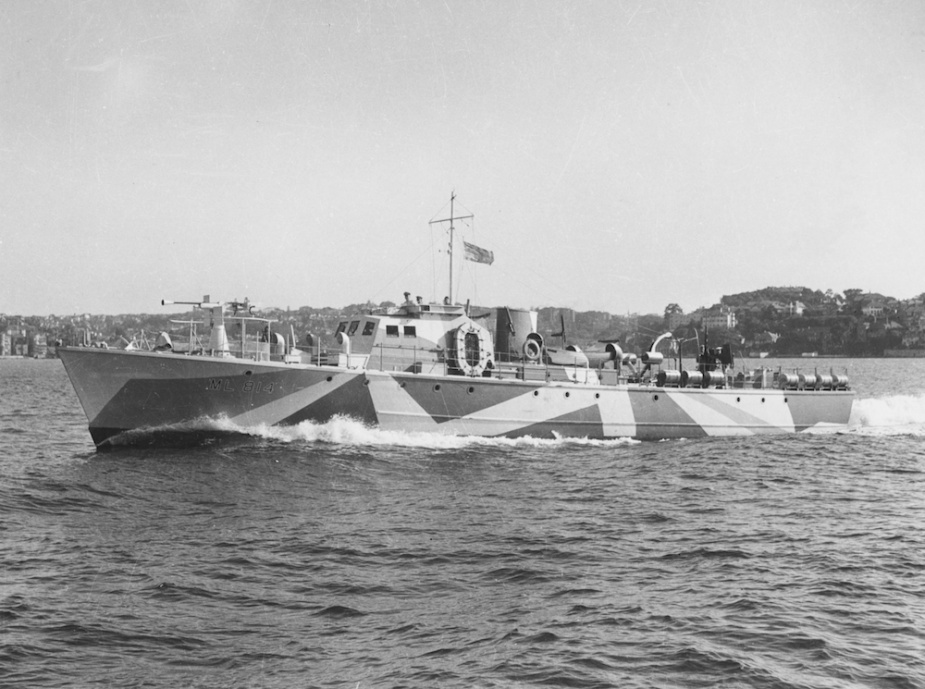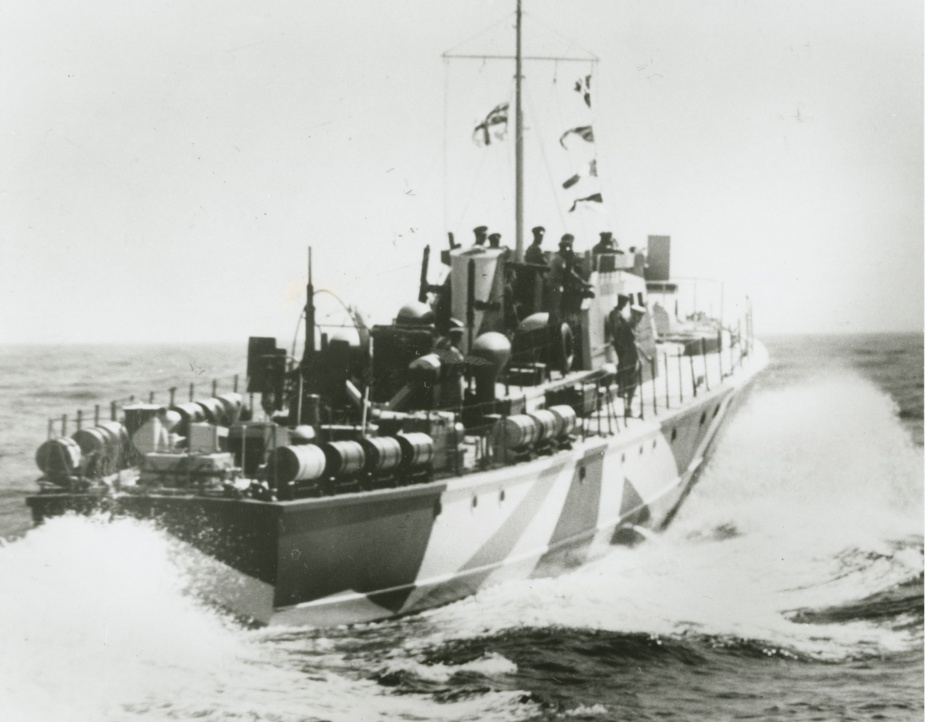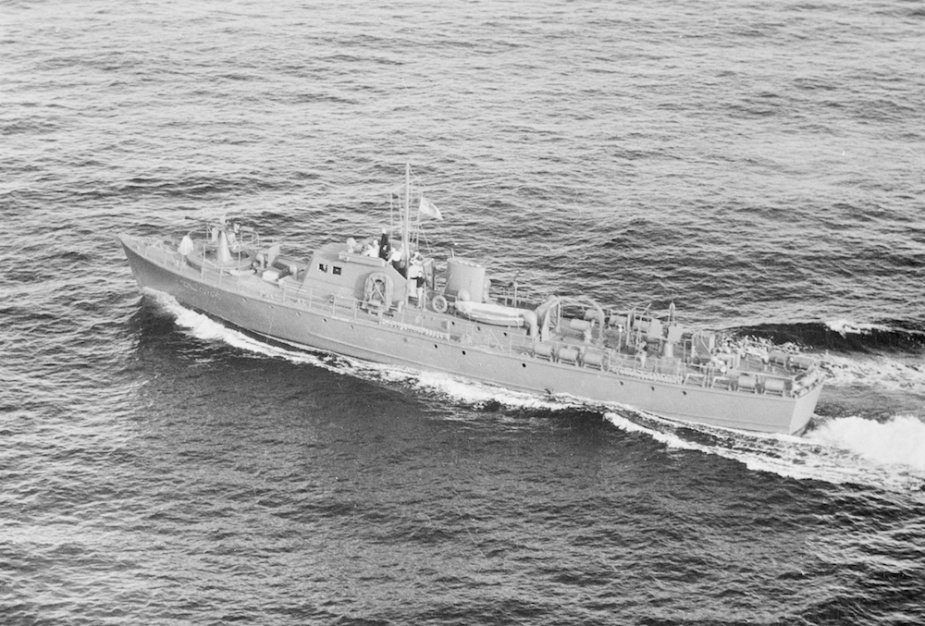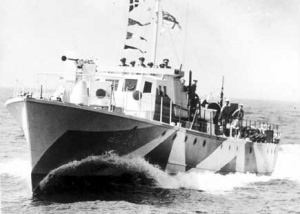Fairmile motor launches were small, fast, highly manoeuvrable, lightly armed ships designed in the United Kingdom. They were originally intended to be used for coastal anti-submarine and convoy protection duties but soon proved to be vessels capable of much broader operational tasking.
In April 1941 the Royal Australian Navy (RAN) recognised the need for a vessel which could be built locally and used in the littoral waters of Australia, New Guinea, the Dutch East Indies and their surrounding islands. On 5 January 1942 the War Cabinet gave approval to construct Fairmiles in Australia. Between November 1942 and April 1944, 35 vessels were commissioned into RAN service.
ML 814 was the second of the Fairmiles to be constructed in Australia. It commissioned on 1 January 1943 under the command of Lieutenant Gilbert R Kennedy RANVR, a veteran of small ship actions fought against German E boats in the English Channel while serving with the Royal Navy.
Unlike other Fairmiles that were being brought into service, 814 was painted in a distinctive zigzag disruptive camouflage pattern with hues of white, light blue and green being used to break up its appearance. This colour scheme was later determined to be impractical to maintain and in time it reverted to the normal plain grey found on most other RAN vessels.
Living conditions in Fairmiles were spartan. There was a small wardroom which the 3 commissioned officers shared, a cabin for 2 Petty Officers (normally the Coxswain and Petty Officer motor mechanic) and a small mess deck which accommodated 12 sailors. There were no showers and just 2 small hand pumped toilets. As the complement sometimes varied between 17 and 20, additional crew were faced with either sleeping on deck or adopting what was known as a ‘hot bunking’ routine in which they took turns sharing a bunk with a shipmate who was on watch. For the sailors all activities such as sleeping, eating and relaxing took place in the mess deck.
Operation LAGARTO/MOSQUITO
On the morning of 26 July 1943, Lieutenant Lewis and Lieutenant Charles A J Inman, RANVR, the commanding officer of ML 815, were briefed to prepare their ships to proceed to Japanese occupied Timor in support of Operation LAGARTO. The naval component of the mission was named Operation MOSQUITO and required the 2 Fairmiles to slip deep into enemy controlled waters and resupply the Portolizard guerrilla group. They were also to insert an Australian Army signaller (Sergeant A J (Jim) Ellwood) and evacuate approximately 70 civilian refugees.
The MOSQUITO operation was among the first of several clandestine activities in which the RAN Fairmiles and Harbour Defence Motor Launches (HDML) supported the Allied Intelligence Bureau (AIB) and Services Reconnaissance Department (SRD).
There was little time to prepare for the impending operation which called for a landing on Timor within 3 days. The Fairmile’s depth charges were unloaded to provide extra deck space, and a special launching ramp was built over the stern of each of the 2 MLs to enable the rapid deployment of a large wooden and canvas landing craft. These craft were to be pushed into the water to seaward of Timor’s surf and rowed inshore to land stores and provisions. They would then return to the Fairmiles with the civilian evacuees and be taken in tow for the return voyage to Darwin.
Final preparations were made at the secret AIB base located about 18 miles from Darwin on the east arm of the harbour. Here the landing craft was loaded in 814 and members of the SRD, the army’s ‘cloak-and-dagger’ men, embarked along with a specialist navigator, Lieutenant W B Hill RANVR, and a Portuguese navigational pilot named Baltazar.
At 10 pm on 27 July, the 2 Fairmiles set course for Melville Island. The following morning, they arrived in Kings Cove, St Asaph Bay where they rendezvoused with the tender, HMAS Terka, to take on additional fuel and water. Later that afternoon they continued their passage bound for a reference point on the southern coast of Timor close to the mouth of the Dilor River. In the early hours of 29 July, radio silence was broken when a signal was received recalling both vessels to their staging position. No reason was given and by 7 pm they were again in St Asaph Bay refuelling. The ships remained there for 2 days awaiting further orders before they were eventually recalled to Darwin. The mission had been postponed at the request of an operative in Timor who was concerned about the presence of Japanese forces in the landing area. The operation was soon rescheduled to take place on 3 August.
The 2 MLs re-embarked their cargo of equipment and personnel. At 10.31 pm on Monday 2 August they set out again, this time refuelling at Snake Bay, Melville Island. At 5.30 pm the next day they proceeded on a north-westerly course for the position on the south coast of Timor. The night passed without incident and early the next morning they were joined by their RAAF Beaufighter escort which maintained a presence until late that afternoon.
Just after nightfall the 2 Fairmiles closed the rendezvous position where they observed 3 small fires on the beach. This was followed by the reception of a faint blue recognition signal from the shore. Baltazar confirmed that they had arrived at the correct location on the chart and the Australians quickly set about lowering their landing craft.
With their vessels loaded with provisions, the crews of 814 and 815 headed through the surf towards the shore where they were eagerly met by the guerrilla force. ‘Chips’ Wood commanded the first landing party from 814 and was soon busily overseeing the insertion of Sgt Ellwood, the unloading of stores and the embarkation of the first load of refugees. After about 15 minutes he returned to 814 where Hordern relieved him to oversee the subsequent landing parties.
After several further boat trips, the 2 Fairmiles took their landing craft in tow at 10.50 pm and shaped course for Darwin. The return voyage was made at a brisk 17 knots with the aim of putting as much distance as possible between the Australian ships and any Japanese patrols before daybreak. Dawn the following day revealed the desperate state of the refugees embarked in 814. Many were suffering from malnutrition, wounds and tropical ulcers. Nearly all of them were seasick. The crew provided what assistance they could, but it was a great relief to all on board when they finally secured alongside Darwin at 11.30 am on 5 August. Ambulances and medical attendants transferred 814’s passengers to hospital for treatment and observation.
Operation COBRA/BULLDOZER
Operation COBRA/BULLDOZER
Towards the end of January, 814 supported another SRD operation, known as COBRA. The naval component of the operation was called BULLDOZER. As with the LAGARTO/MOSQUITO operation, it involved carrying and inserting SRD and Z Special Unit operatives into Timor. This time, however, 814 would sail alone.
There was little time to prepare for the mission which again called for carrying a special landing craft and building a temporary cradle and launching ramp over the stern.
The COBRA landing party was embarked at Shell Island at 8 pm on 27 January. 814 sailed from Darwin at 11 pm for St Asaph Bay, Melville Island, where it refuelled from the tender HMAS Coolebar the following afternoon. At 7.20 pm on 28 January, 814 cleared St Asaph Bay and set course for its destination, a point near the western entrance of the Dara Bai River on Timor.
As 814 made its approach, numerous shore lights were observed and the ML issued challenges by flashing light. They received no reply. 814 continued on a southerly course. At 11.40 pm, when it seemed likely that the party would have to be landed without assistance from the shore, the designated signal of 3 fires on the beach was observed. The Fairmile anchored and began ferrying the guerrilla’s stores and equipment ashore.
The COBRA operation was doomed from the outset when details were communicated by SRD HQ in Melbourne to the already compromised LAGARTO group. This enabled the Japanese to plan to apprehend them shortly after their insertion.
Operation ADDER
During the period that 814 was undergoing refit, SRD HQ continued to plan and execute further clandestine operations around Timor. ML 429 (Lieutenant H F Wadds DSC RANVR), another Fairmile, was directed to operate in support of Operation ADDER in May. However, following a close encounter with a Japanese encampment and after running into difficulties off Timor and losing its landing craft, the mission was aborted. A further attempt to insert the SRD’s ADDER party was again aborted when 429 was spotted by an enemy aircraft.
In mid-August, the operation was ordered to proceed despite protests by the 3 senior officers involved, who believed that to continue with the same operational plan would be reckless and put lives at risk. Finally, after 2 further attempts, the ADDER party was successfully landed on the northern tip of Timor on 21 August.
It would be years before the Fairmile crews who took part in the MOSQUITO, BULLDOZER and ADDER operations learned of the fate of the SRD men they had come to know and support in operations.
By November 1944 the AIB’s advanced operating base in Darwin, known as the Lugger Maintenance Section (LMS), had become suspicious that both the LAGARTO and COBRA parties in Timor may have been compromised. Without informing SRD HQ, or the suspect Timor parties, it was arranged for Captain A D Stevenson and Sergeant R G Dawson, both of ‘Z’ Special Unit, and Celestino dos Anjos, a Timorese guide, to be parachuted into Timor 2 days ahead of a proposed supply drop to LAGARTO. No resupply was ever intended, but on the night of 29 June 1945, Stevenson’s party, operating under the codename SUNLAG, landed safely in an area close to the signalled drop zone and prepared to observe any Japanese intervention.
It was here that Stevenson saw Ellwood of the LAGARTO party approach under armed guard carrying a signalling lamp. The AIB now had proof that LAGARTO was in enemy hands and that Ellwood was being forced to make the bogus transmissions. Due to problems with their radio set, Dawson was unable to inform Darwin of the compromise until 3 July. In the meantime, yet another party had been inserted by parachute.
This party known as SUNCOB comprised Captain P Wynne and Corporal J B Lawrence, both AIF and Z Special Unit men. Both were captured and tortured by the Japanese who soon learned of the existence of the SUNLAG party and immediately committed a large force to hunt it down. The rescue of SUNLAG was now paramount and although Stevenson and Dawson were competent bushmen, the LMS considered it only a matter of time before they were captured.
On 15 July arrangements were made to extract them using the captured Japanese trawler, Krait, which was to meet them close to the mouth of the Dilor River. Strong winds, poor visibility and other contributing factors resulted in this attempt being aborted and a further extraction, codenamed BRIM, was arranged. This time Harbour Defence Motor Launch 1324 under the command of Lieutenant R G Evans RANR, was the rescue vessel and the operatives, who were in a very poor physical state, were finally extracted on 5 August. ML 1324 arrived back in Darwin on the evening of 6 August. Stevenson and Celestino survived the ordeal but Dawson, who was rushed to hospital on arrival in Darwin, died from kidney failure 2 days later.
A subsequent report concerning the SRD’s operations in Timor stated:
The LAGARTO Operation has no redeeming feature. It is a story of hardship, death, torture, humiliation and degradation meted out by a ruthless enemy. It is a story of colossal waste, since all subsequent operations in the area for a period of 2 years depended on the assumption of LAGARTO’s freedom. It produced nothing whatever of value and neither did the subsequent operations.
Final years
ML 814 continued to operate from Darwin performing anti-submarine patrols, boom defence patrols and escort duties until 19 May 1945 when it sailed for Brisbane calling at Cairns, Townsville and Gladstone en route.
It paid off at the small craft base in Brisbane on 12 October 1945 having covered an impressive 30 154 nautical miles during its wartime career. Its hull was sold for disposal in Brisbane on 30 August 1947 for ₤200.



